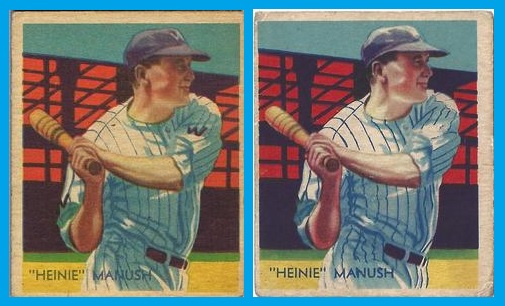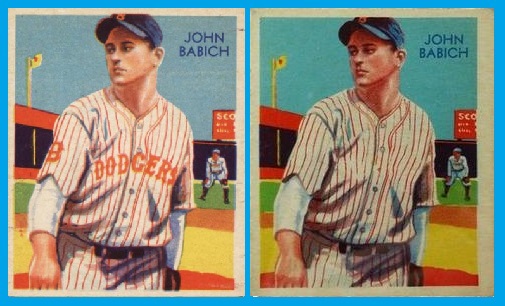The 1934-1936 Diamond Stars (R327) set from National Chicle takes a distant back seat to the Goudey sets from 1933 and 1934 in terms of its hobby profile. As a result, many collectors are unaware of the significant number of team variants in the set, even after consulting with top hobby resources such as the PSA website and the Standard Catalog.
The purpose of this article is to catalog all such variants in a single location where they can be accessed centrally by collectors.
Front variants
While card front variations for Simmons and Manush are known to many collectors, the Diamond Stars set actually includes five (or six, depending how you want to count) players whose card fronts depict team changes.
#2 – Al Simmons (White Sox and Tigers)
Bucketfoot Al spent 1933-1935 with the Chicago White Sox, and his Series 1 (1934) and Series 2 (1935) printings reflect this. However, Simmons was also included in the Series 3 (1936) printing as a member of the Detroit Tigers. Note the whiting out of the Sox logo from his uniform.

#10 – Roy Mahaffey (A’s and Browns)
Mahaffey played for Connie Mack’s squad from 1930 to 1935, and his cards in Series 1 (1934) and Series 2 (1935) reflect this. He moved to the St. Louis Browns in 1936, which his Series 3 (1936) card solves by removing his jersey logo.

#15 – Dick Bartell (Phillies and Giants)
Bartell played for the Phillies from 1931-1934, and his Series 1 (1934) card 15 reflects this. In 1935 he moved to the New York Giants, which is reflected by the hat and jersey updates on his Series 2 (1935) card 15 as well as his card 101 from Series 3 (1936).

#30 – Heinie Manush (Senators and Red Sox)
Manush played for the Senators from 1930-1935, and his Series 2 (1935) card reflects this. Following the 1935 season he moved to the Red Sox, so his Series 3 (1936) card omits the W logo on his sleeve.

#82 – John Babich (Dodgers and Bees)
Babich was a Dodger in 1934 and 1935, and his Series 2 (1935) card reflects this. He spent the 1936 season with the Boston Bees (Braves), hence his Series 3 (1936) card omits the “B” from his sleeve and “Dodgers” from his chest.

#108 – Wally Berger (sort of)
Wally Berger’s card 108 is of special interest though there’s neither a team change behind it nor multiple card fronts associated with the same card number. Rather, we simply see “BRAVES” vanish from Berger’s jersey between his 1935 card #25 and his 1936 card #108.

For what it’s worth, Berger was traded by the Braves to the Giants. However, this exchange did not occur until June 15, 1937, long after his card #108 was issued! Was Berger’s card 108 a case of cardboard clairvoyance or is there something more behind the team-less jersey? I did some searching on newspapers.com to see if Berger might have been the subject of trade rumors in 1936 since that seemed the most likely reason for National Chicle to modify the card in this manner. Sure enough, there does seem to have been a lot of buzz around Berger.
Here is the February 7, 1936, Decatur (Illinois) Daily Review, for example.

Now fast forward to the end of the month, per the February 28, 1936, News-Palladium of Benton Harbor, Michigan.

Just a couple days later, things seemed to be getting serious, if the March 2, 1936, McCook (Nebraska) Daily Gazette is to be believed.

Fortunately for the Bees faithful, Berger did in fact sign only a few days later on March 5. Not knowing any other reason why National Chicle would take the trouble of removing “BRAVES” from his jersey, I have to imagine the trade rumors swirling around their hometown star were the reason. Then again, they kept the “B” on his cap…
…which leads me to a more likely explanation. On January 31, the Braves became the Bees. While Berger’s bio did not reflect the update, I believe this is the most likely cause for the redone jersey.
Back variants
In addition to the cards already presented, three other players, such as Johnny Verges below, have team changes noted in their bios while card fronts remain identical.

Here is the complete list of players.
- Johnny Vergez #21 – With the Giants in 1934 series and Phillies in 1935 series.
- Al Lopez #28/97 – With the Dodgers in 1935 series (card #28) and the Bees in 1936 series (card #97).
- Kiki Cuyler #31 – With the Cubs in 1935 series and Reds in 1936 series.
The design of the Lopez and Cuyler cards were such that there were no logos or team names evident, which likely explains why no artwork was changed when the players changed teams. Of course, had their hats included team logos, there may still have been no changes required as Lopez simply moved from “B” to “B” and Cuyler moved from “C” to “C.”

The case of Vergez is more perplexing as his uniform appears to have been that of the Pacific Coast League’s Oakland Oaks but was used for both his Giants and Phillies cards!
Other team changes
While the Diamond Stars set included eight players whose team changes were explicitly noted, there were other players in the set who changed teams between 1934 and 1936 but did not yield variants, generally because the card was not part of subsequent printings or the transaction occurred after the third printing was already finalized.
Here is a complete listing of all such players. In nearly all instances, reconciling the transaction date with the timing of the card’s release leads to unsurprising results. However, there are three exceptions (highlighted) that will be addressed separately below the table.

- Red Lucas last pitched for the Reds in 1933, so it’s surprising that his 1935 and 1936 Diamond Stars cards, numbers 46 and 106 respectively, still describe him as a Reds pitcher in the bio section. I regard these cards as having uncorrected errors (UER) for this reason.
- Tony Piet did not join the White Sox until June 1935. Nonetheless his 1935 card described him as a “former Pirate infielder now with White Sox.” What this suggests is that the Piet card was part of a mid- or late-season release in 1935. (Though no team change is involved, at least one other card in the set showing evidence of a midseason release is that of Cy Blanton.)
Other variants
I will not focus on other variants in this post. Other hobby resources will be much more complete and authoritative in this regard. Instead I’ll simply list the most notable examples.
- The Hank Greenberg and Ernie Lombardi cards from 1935 have each player’s name misspelled and then corrected.
- Series 1 cards have green ink backs and reflect 1933 statistics.
- Series 2 cards have green ink or blue ink backs and reflect 1934 statistics.
- Series 3 cards have blue ink backs and reflect 1935 statistics.
Three good sources for learning more about the Diamond Stars set are Anson Whaley’s Pre-War Cards site, Matthew Glidden’s Number 5 Type Collection blog, and Cardboard Connection.

The Berger variation was to get “BRAVES” off the shirt when the team was changing its name in the off-season of 1935-36 (ultimately, from Braves to Bees)
LikeLiked by 1 person